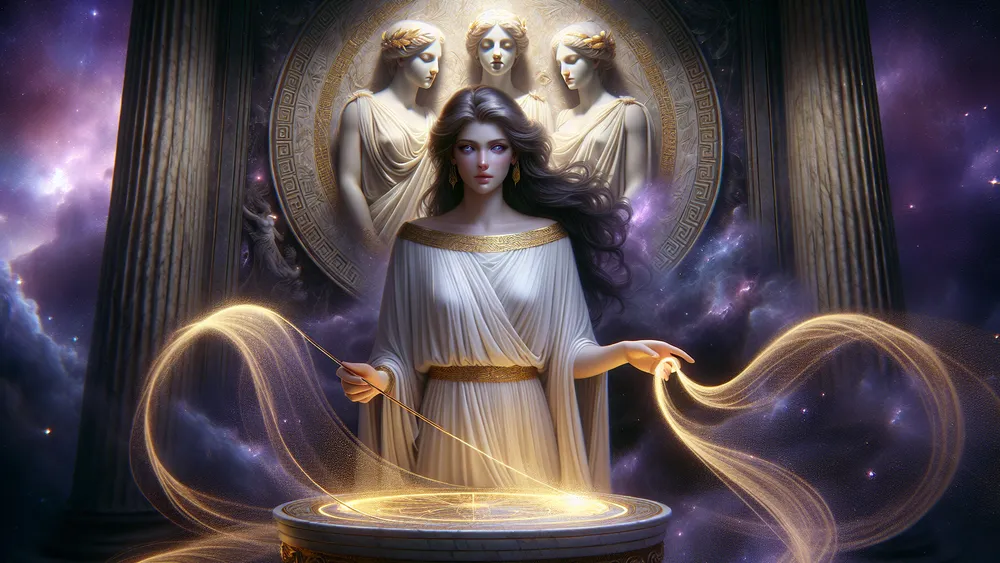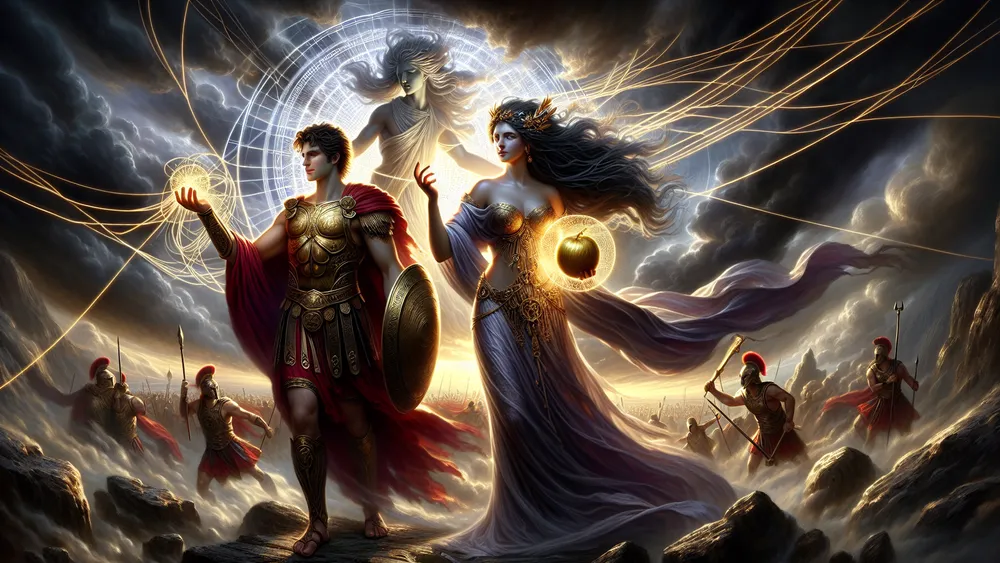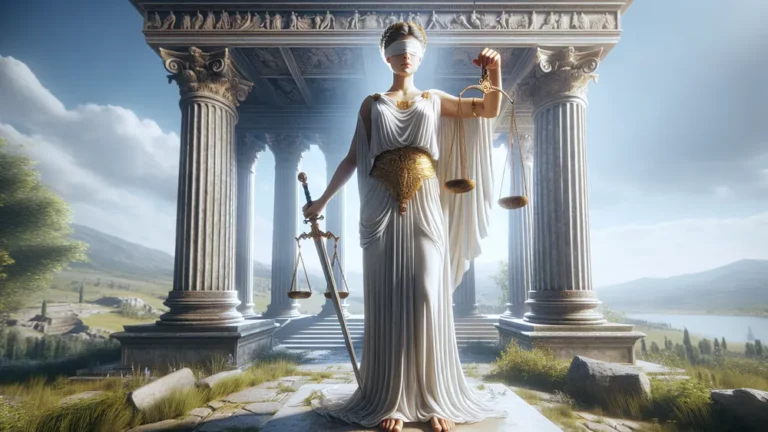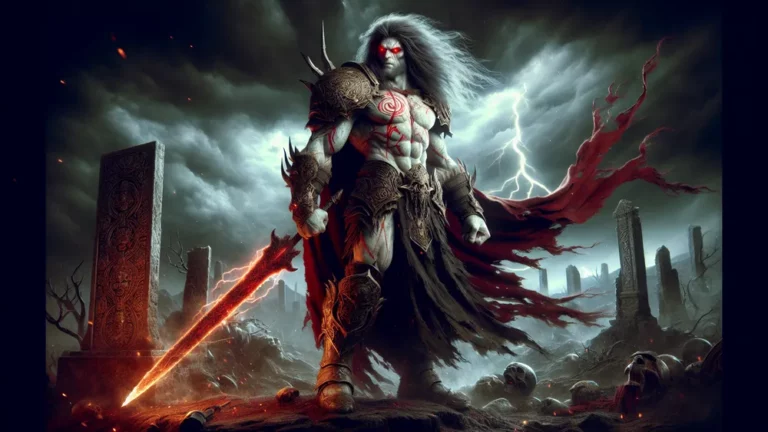Lachesis: The Measurer Of Life’s Thread In Greek Mythology
In the intricate and very meaningful world of Greek mythology, Lachesis comes across as a significant figure tied to one of the most basic parts of life: how it moves forward and how death is guaranteed.
Key Points:
- Lachesis measures the thread of life, deciding how long each person lives.
- She is one of the three Moirai, the Fates, alongside Clotho (who starts the thread) and Atropos (who cuts it).
- Her name means One Who Divides or Distributor of Shares, symbolizing her role in portioning out life.
- Lachesis represents balance, limits, and the inevitability of destiny.
- She is often associated with tools like a measuring rod or staff in mythology and art.
- Ancient Greeks believed she worked as part of a higher order controlling life’s structure.
- Similar figures appear in other myths, like Decima in Roman stories and Urd in Norse legends.
She is part of the Moirai, also known as the Fates, who are strong deities believed to have control over every person’s lifetime, from birth to its end. Together with her sisters Clotho and Atropos, Lachesis stands for a certain point in how every person’s life unfolds. Think of the Moirai as divine workers piecing together the fabric of what it means to live.
Clotho spins a new thread to start someone’s life, Lachesis decides how long that thread will be, and then Atropos brings it to an end by cutting it, meaning the moment life stops. Lachesis has a special role. Her part, measuring the thread, is like giving out a set amount of something that cannot go on forever.
This makes life seem limited but meaningful once you think of it. If you really take a closer look at her story, you will notice she matters not only for what she does but for what she stands for: balance, inevitability, and the shared limits that apply to everyone.
Through her careful deciding of how long life should last, Lachesis became a symbol of forces like determinism and how delicate life is – ideas that held a deep place in the thoughts of the ancient Greeks and still interest us even now.
Lachesis: Overview and Key Facts
| Key Aspect | Details |
|---|---|
| Name | Lachesis (Λάχεσις in Ancient Greek), meaning “One Who Divides” or “Distributor of Shares” |
| Role | She decides how long people live by measuring the thread of life carefully. |
| Group | Part of the Moirai, along with Clotho (who starts the thread) and Atropos (who cuts it). |
| Symbolism | She stands for balance, fate, how life cannot go on forever, and the idea of human limits. |
| Family | Said to be one of the daughters of Nyx, the goddess of night in Greek myth. |
| Etymology | Comes from the word láchos, which means “share” or “portion,” matching her job of dividing life spans. |
| Cultural Function | Represents the idea that people’s lives are set by higher forces and follow rules beyond their control. |
| Representation in Art | Often pictured using tools like a measuring rod, staff, or globe to reflect her role of measurement. |
| Notable Texts | Clear mentions in Hesiod’s Theogony and indirect references in works by Plato and others. |
| Philosophical Significance | Important to discussions of control versus choice in Greek thinking, especially in dramatic and philosophical writings. |
Getting to Know Lachesis in Greek Mythology
To fully understand the important role of Lachesis in the group called the Moirai, you need to look at the ways she and her sisters together decide what happens to both humans and gods. These decisions are what give shape to their joint duties. Instead, it’s through their shared work on fate that each of them holds part of the process.
By examining how these responsibilities are divided, you begin to see their individual roles and how they fit together.
How the Three Fates (Moirai) Shape Our Lives
The Moirai, or the Fates, are a group of three powerful beings in Greek mythology who are believed to control the destiny of humans and gods. These sisters – Clotho, Lachesis, and Atropos – each manage a specific part of life. Together, they create the thread of life, which is an idea that means life itself is set and cannot be changed.
They don’t only decide single moments, but instead, they control every part of life, from when it starts to how and when it ends. This balance is seen as part of the universe itself, showing how every life happens under rules that cannot be changed. Through their combined work, they keep life predictable.
Each one has her own job, but together they make sure everything follows the order decided by the gods. Some stories say the Moirai come from Nyx, the goddess of night, while others describe them as daughters of Zeus – but regardless of their origins, their shared purpose is clear: they set destiny for everything that exists.
Their jobs include these:
- Clotho: She starts the thread of life. With her spindle, she begins a new life by creating its thread.
- Lachesis: She decides how long the thread will be, meaning how long a person will live. A rod or staff is her tool.
- Atropos: She ends the thread. Using shears, she determines when life will stop.
By working together, they represent a force that is higher than choices or actions, showing that every life has its length and end carefully decided by them. These sisters make it clear that no one – human or divine – can escape the limits of life.
The Moirai, three sisters in Greek mythology, control every life from start to end, deciding its length and limits with powers even gods cannot escape.
What Lachesis Does and What She Represents
The name Lachesis (Λάχεσις) comes from the Greek word láchos. This word means “lot” or “share.” It fits her job, which is all about dividing up life into the right portions. Lachesis is the one who decides how long each life lasts, assigning its length carefully within the system controlled by the Moirai.

In the idea of the “life thread,” she is the one who measures the thread for each person, determining their lifespan. Her name explains how the ancient Greeks thought of the universe as ordered and deliberate, where life is given out just the way rations might be in daily life.
There is no randomness in this process, and no one gets the choice to change it. Lachesis can be imagined as a careful worker who uses a rod or staff to measure an exact amount of thread before passing it to her sister Atropos, who ends the thread by cutting it. Her role comes after Clotho, who starts the thread, and before Atropos, making her the middle step in how the three Fates work.
Outside of her specific job, Lachesis represents the idea of balance in life. Her act of measuring defines how life has both its possibilities and its constraints. It is less dramatic than Clotho’s beginning work or Atropos‘ final actions, but her role is necessary for everything to fit together.
She shows that life has limits that cannot be ignored, not even by the gods. Lachesis neither adds nor removes from the thread; she simply measures it as it is meant to be. This is how she helps to keep things organized between the start and end of life.
| Fate | Role | Symbolism |
|---|---|---|
| Clotho | Spins the thread, creates life | Start, birth, life |
| Lachesis | Measures thread, decides length | Balance, limits |
| Atropos | Cuts thread, ends life | Death, finality |
Understanding Lachesis helps clarify how the ancient Greeks saw life as a system that was both balanced and beyond human control, where each person’s time is carefully set by forces greater than themselves.
Lachesis in Ancient Texts and Classic Stories
Lachesis, as a figure of mythology, first appears in Hesiod’s Theogony. This is one of the key works of Greek myth that explains the origins of the Moirai, who are daughters of Nyx (Night). Nyx, a deity who stands for darkness, is thought to pass her role of controlling mortal destinies to her daughters.
Lachesis, as the one who divides life into portions, is immediately linked to how the gods maintained control over both mortal and divine lives. Hesiod explains the Moirai as forces that act without bias and cannot be avoided, ensuring that everything in life follows a strict system. For Lachesis specifically, her role is to measure out life carefully in accordance with a divine plan.

This way of seeing fate – where everything follows a controlled and predictable order – helped the Greeks understand themselves in relation to powers greater than human choice. Other stories tell slightly different tales. In some, the Moirai are described as the children of Zeus and Themis, who is the goddess of law.
These differences show how Greek mythology could change between traditions, but Lachesis’ role stayed the same: dividing life’s time fairly according to what was decided by higher powers. Later, in philosophical works by authors like Plato, Lachesis moves from being a mythological figure to one that explains intellectual ideas.
In Plato’s Republic, her role expands to include helping souls select their next lives. In this story, known as the “Myth of Er,” Lachesis stands as a symbol of balance and fairness. She gives a portion of time for each life and ensures that the system stays impartial.
This idea matches the way Plato saw the Moirai in general: as reminders that people have some freedom but live within limits set by fate. Because of these texts, Lachesis became more than just a goddess in stories. Over time, she stood as an idea that life was not random but followed a structured plan. As myths became more complex, Lachesis was often included indirectly.
Her decisions were thought to have shaped the lives of characters like Meleager and Achilles but were not shown in the stories themselves. Instead, she was like a quiet yet constant presence, one that helped the Greeks explain their ideas about control, order, and destiny – not just for individuals, but for the world itself.
Stories Where Lachesis Takes the Stage
The part Lachesis plays in dividing the lives of mortals is clearly seen in many well-known mythological stories. In these narratives, her work changes what happens to both heroes and even the gods themselves. Though she appears indirectly, her role is always important. By looking at these specific stories, you can understand her role better.
Her unseen influence, in deciding how long a life will last, forces heroes and gods alike to follow what is already planned.
The Hero Meleager and His Magical Firewood
The sad story of Meleager, a famous hero in Greek mythology, gives a clear example of how life’s time is decided by Lachesis and cannot be avoided. It begins when the Moirai, who control fate, make a prediction about his life. At the time of his birth, they said his life would last only as long as a single log stayed unburned.
The log, simple but important, was tied directly to his lifespan and would decide how many years he got to live. His mother, Althaea, heard this and quickly took the log from the fire to protect him. She hid it away to make sure that her son could keep living.
This event explains how Lachesis worked – she connected the life of Meleager to the time it would take for the log to burn. She did not appear, but her choice to decide Meleager’s time in this exact way means her role in fate had a very real, physical impact. For those who may find this confusing, imagine Lachesis as giving him a “thread” of life that depends entirely on the unburnt piece of firewood.
But things changed as the story continued. Years later, Meleager killed his mother’s brothers during a deadly argument after the Calydonian Boar Hunt. Althaea, who was once the loving mother hiding the log, now acted against him in her grief and rage. She found the log and decided to throw it into the fire. The moment it burned away, just as the prophecy had said, Meleager’s life ended.
Throughout this story, the work of Lachesis is always present even though you do not see her directly. The way she measured his life span, through the time of the log, makes it clear that destiny is fixed and cannot be changed.
This story explains many ideas: how the Moirai decide life and death, the emotional cost of fate on people, and the balance between human choices and the order of the universe. These decisions of fate, decided by Lachesis, remind us that no matter how much effort is made to change destiny, it is still controlled by forces far greater.
Pelops Lives Again – With the Moirai’s Help
The story of Pelops is about death and life, where fate and the gods play major roles together. In the myth, Pelops’ life changes after his father, Tantalus, commits a terrible act. Tantalus decides to test whether the gods really know everything. To do this, he kills his own son, Pelops, and serves him as food during a feast with the Olympians.
At the time of this event, the gods notice the offense immediately, but Demeter, who was distracted by sadness over her lost daughter, eats a piece of Pelops’ shoulder. After stopping Tantalus’ offense, the gods act quickly. They punish him for what he has done and bring Pelops back to life.
His body is put back together by the gods, and for the missing shoulder, Hephaestus replaces it with one made of ivory. The gods’ actions give Pelops life again, which is rare for mortals. By doing so, they bring the Moirai into the story to make sure Pelops gets a fair amount of time for his second chance at living.
In this story, Lachesis plays a significant part. Her duty is deciding and assigning lifespans, and here, she changes Pelops’ life thread to let him live again. Normally, once fate is given, it cannot be undone, but Pelops is an exception because the gods intervene.

What this story means is that even in rare cases where the gods bend the rules, the Moirai still make sure that balance and order are kept. Through Lachesis’ work, Pelops’ new life is tied to the rules of fate, keeping everything fair in the universe. This rare story shows how even when changes happen, the Moirai retain control to ensure that no rule-breaking leads to chaos.
Although the gods can act to reverse death, they still operate within the system that Lachesis and her sisters enforce.
The myth of Pelops reveals how the gods, despite bending rules to bring him back to life, still depend on the Moirai to keep balance and order intact.
The Trojan War, Paris, and the Moirai’s Plans
The Trojan War, one of the most famous stories in Greek mythology, mostly happened under the unseen role of the Moirai. Among them, Lachesis helped decide the lives of the important figures. Although the gods stepped in and acted directly many times, it was how Lachesis measured people’s lives that decided what would happen.
She made sure each of their actions would fit into an even bigger plan. Paris‘ decision, which started the war, happened because Lachesis had decided that he would play this role. He gave the golden apple to Aphrodite, and because of this, the events leading to the war began.

Achilles, another key figure, was given a short life but also had a destiny of being remembered forever as a great warrior. His time was limited, but his name would never be forgotten. Hector, on the other hand, was destined to fight bravely and die at the hands of Achilles, ensuring he would always be a symbol of honor and courage.
Lachesis worked in a way that was fair, carefully deciding how these lives connected to create the war as part of a planned story of struggle and heroism.
- Paris: His life was decided so that he would pick Aphrodite to win the golden apple. This started the events of the war when Helen was taken to Troy.
- Achilles: Lachesis decided he would live only a short time but that his name and glory would last forever.
- Hector: He was given a brave and noble role in the war, but one that ended with him being defeated by Achilles. His memory, however, lives on as a hero who fought and died with honor.
Lachesis in Other Cultures and Myths
The role of Lachesis as the one who measures the thread of life is not something that only exists in Greek myths. This idea is found in other traditions and stories too. Her job has clear similarities with figures in Norse, Roman, and other mythological systems. In Norse myths, there are people who are in charge of life’s threads.
In Roman stories, the same idea exists but in a different way. Although Lachesis is a Greek figure, her job can also be seen in myths from these other cultures.
Lachesis and Similar Figures in Norse and Roman Legends
The role of Lachesis, one of the Greek Moirai, is an idea that also appears in other mythologies. In Norse stories, there are the Norns, who shape destiny and decide what happens to the world and the people in it. Among them is Urd, whose main job is to look at the past, seeing how it affects things both now and later. For Lachesis in Greek myths, her focus is different.

She works on keeping life balanced, measuring how long each person should live. In Roman mythology, the Fates are different again. The Parcae, the Roman version of destiny’s guardians, include one named Decima, who decides how long each person lives. Her role is simple: to measure lifespan. This differs from how the Greeks think of Lachesis.
While Lachesis fits into the Greeks’ belief in an organized universe where everything has a place, Decima reflects the Roman way of looking at life – practical, straightforward, and connected to their ideas of law and structure. These differences explain how cultures see destiny in their own way. Norse myths focus on how time flows from the past, Greek ideas look at balance from a universal view, and Romans tie it to rules.
- Lachesis (Greek): Measures life’s length, keeping it balanced with fate’s plan.
- Urd (Norse): Looks back at the past and uses it to decide how the future unfolds.
- Decima (Roman): Decides how long people live, keeping it practical and clear.
Forces of Nature and Ideas in Greek Tales
In Greek mythology, many ideas and forces in nature are represented as gods or mythological figures. Each one has a specific job that is important to how the universe works. Lachesis is one of these figures. She acts as the symbol of life’s length, standing with others like Chronos (time), Tyche (luck), and Ananke (necessity).
Together, these figures explain how human life is controlled: time moves forward, random events step in, and unchangeable rules connect actions to consequences. For anyone who wants more details, this full list of Greek Abstract and Natural Forces shows their roles in myths and how they are related to one another.
FAQs
1. What are Lachesis’ key symbols and how do they appear in ancient art?
Lachesis’ key symbols, such as the measuring rod or staff, often appear in ancient art to represent her role in determining the length of mortal lives.
2. How does Lachesis’ role differ from Clotho and Atropos?
Lachesis’ role differs from Clotho and Atropos by focusing specifically on measuring the thread of life to determine its length, whereas Clotho spins it and Atropos cuts it.
3. Did ancient Greeks worship Lachesis, and if so, how?
Ancient Greeks did not explicitly worship Lachesis as an individual deity but acknowledged her role within the broader reverence of the Moirai through offerings and prayers for favorable destiny.
4. How is Lachesis’ interpretation similar to analogous figures in Norse and Roman cultures?
Lachesis’ interpretation is similar to analogous figures in Norse and Roman cultures as all embody the concept of measuring or defining the span of mortal life within a predetermined framework of fate.







